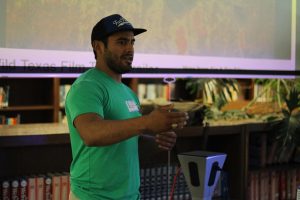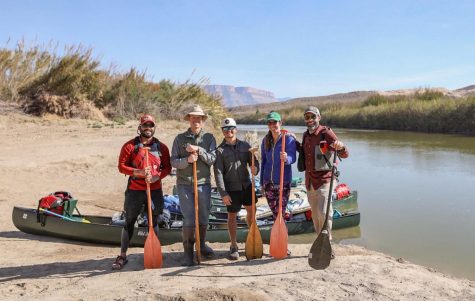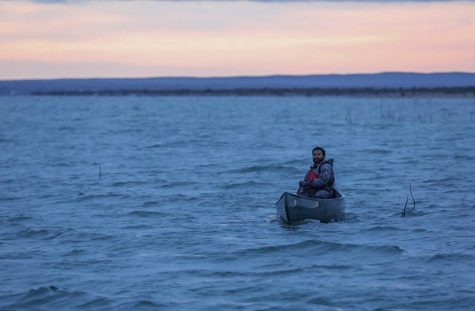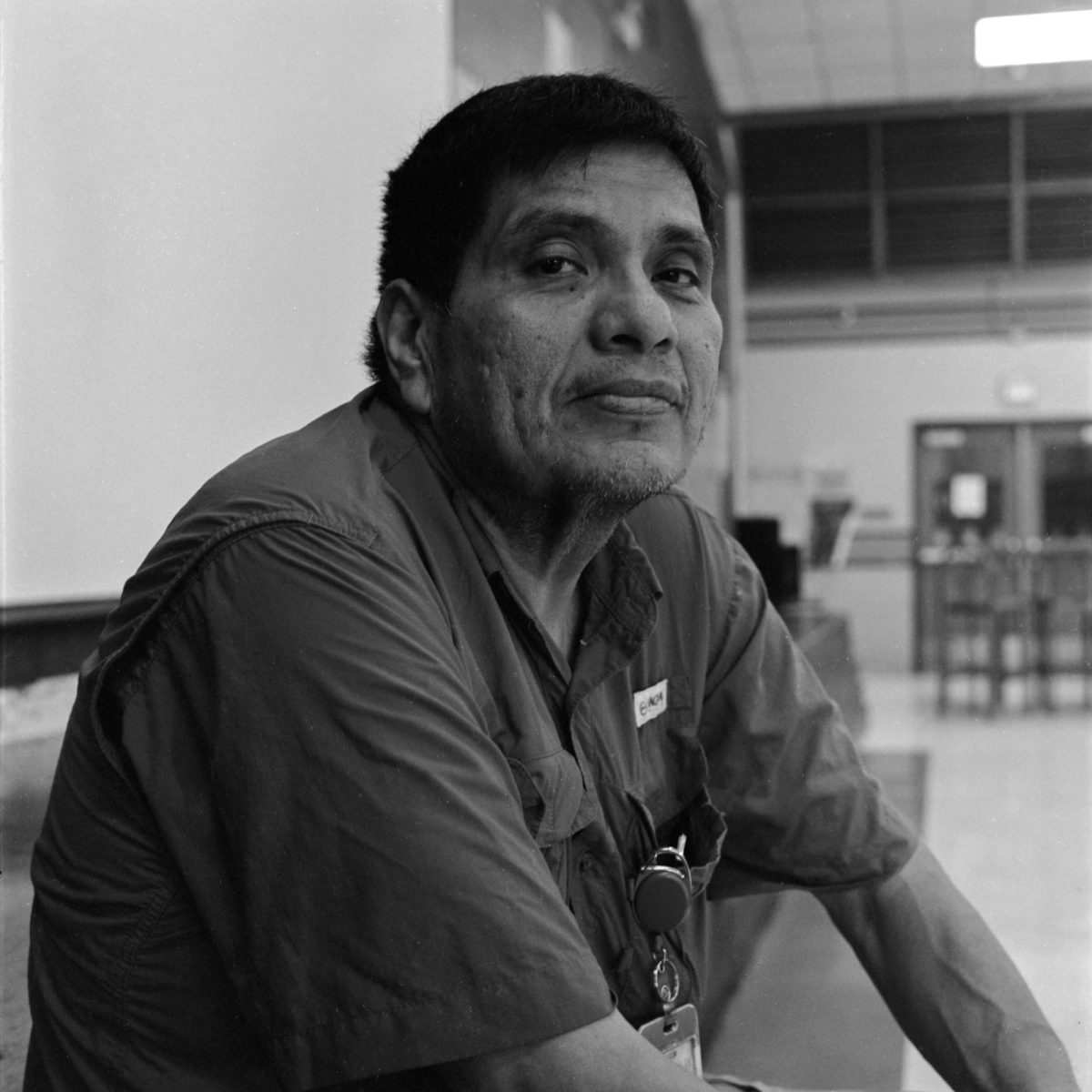Promo used with permission from Hillary Pierce.
McCallum graduate Austin Alvarado returned to his alma mater last November as a speaker on behalf of the school’s Bass Fishing Club. A river guide, Alvarado is not used to interviews or publicity tours, but this presentation is one of many appearances he’s had to make in recent months, as he is one of five characters in a feature-length documentary film, The River and the Wall.
The documentary, produced by Jay Kleberg and Hillary Pierce, explores how building a border wall along the Mexican border would affect the flora and fauna of Texas. It centers on five principal characters, including filmmaker Ben Masters, Kleberg, National Geographic host Filipe DeAndrade, river guide and McCallum graduate Alvarado, and wildlife biologist Heather Mackey. Masters joined Alvarado in the library during the campus visit on Nov. 15.
“You can’t separate wildlife and habitat and conservation in 2017 without looking at the human element, and a 30-foot-high continuous wall going from the Gulf of Mexico to the Pacific Ocean is just going to have so many long-term consequences for wildlife, for water sheds, for animal dispersal, for migration, for everything, and it may or may not even affect our immigration system,” Masters said. “I think it’s incredibly short-sighted, and I think people, before they support an actual physical wall, they need to know what it would do to those landscapes and everything else that lives there.”

The area along the border includes about 25 million acres of public land. These national parks, including wildlife and Native-American sanctuaries, have a profound significance in the lives of the people, animals and plants near the border.
“It’s a long desert, a very broad, diverse desert, that stretches into Mexico and into Texas and some other parts of the country,” Alvarado said. “Within [the desert, however,] we have some of the largest migratory birds back and forth from north to south and south to north, but we also have black bears, mountain lions, javelina, bighorn sheep… we have a lot more to the desert than people realize.”
Alvarado graduated from McCallum in 2010; during his time as a Knight he was involved in PALS, AVID, football and soccer. He then went to Texas A&M, as did Masters, where he graduated in 2014 with a degree in recreation, parks and tourism science. While in college he spent his summers working on cruise ships in the Mediterranean. He now has worked as a river guide on the Rio Grande for five years and is the activities and river manager for Far Flung Outdoor Center in the Big Bend area.
“There’s this guy name[d] Paul McDonald; he did a trip through the entire Rio Grande,” Alvarado said. “And he beautifully put what I’ve been feeling for a long time into words: ‘The Rio Grande is a river before it is a border.’ If that is exemplified through the documentary, [and] that’s all people get out of this, then I’m OK; I’ve done enough. The Rio Grande is a special place; it’s the lifeline for a lot of things out there, and that’s what’s important for me in all of this.”
Masters is best known for his documentary Unbranded on Netflix, in which he and three other people rode 12 wild mustangs from the Mexican border to the Canadian border to explore the world of mustang management. He has also has had films, essays and photography featured in National Geographic Wild.
“The big gap that I saw between the sciences and research was the ability to tell those stories in a manner that was consumable by the general public because the general public is not just going to pick up a scientific publication and spend 35 minutes reading about the intermediate disturbance hypothesis or the central place foraging theorem, because they don’t care,” Masters said. “It doesn’t affect them in their lives. So I started making films to try to take different wildlife research and different conservation efforts and tell the story so that people watch it and then they learn something about wildlife, but then they also care about it too, and instead of a hundred people reading your wildlife research pub, I’ve had videos that have had 5 million views. But I didn’t study film, I just went and bought a camera.”
The filmmakers say they are attempting to document the environment for posterity, in case a border wall changes the ecology of it forever, and explore the ways the wall would affect immigration, the wildlife and those inhabiting the area.
“Texas does a pretty bad job with public land to begin with. … Again, going back to the Rio Grande, if we could make it a point to say, ‘Hey, this is a recreational area that deserves respect, that deserves a degree of availability to everybody,’ … we’ve done a good job, at least as far as hitting the points on conservation [for] public land,” Alvarado said. “If this border wall is built, a lot of those sanctuaries [by the Rio Grande] are out, which is depressing beyond words.”
The film is, in part, funded by donations, and prior to Masters and Alvarado’s visit, the Bass Fishing Club raised around $600 to give to them.
Christopher Watson, the teacher sponsor for the club, said that when he saw that his former classmate Alvarado was in the film, he immediately asked him to come give a presentation.
“I felt like The River and the Wall has something for everyone,” Watson said. “Immigration policy, specifically ‘the wall,’ is a really sensitive and controversial subject right now, and I thought that this project explores the conversation in a new way that may be able to highlight so many more complexities of building a wall than we hear on the news.”
The club hosted Masters and Alvarado on Nov. 15, 16 days from the beginning of their journey. They began the trip on Dec. 1 and will finish it tomorrow, Feb. 10.
Listen to Masters and Alvarado’s presentation to the Bass Fishing Club here.
The 1,200-mile trek began at the segment of the Rio Grande where Texas, Mexico and New Mexico intersect. They traveled past El Paso on mountain bikes through the Forgotten Reach, a 100-mile stretch where the river is completely dried up. When they arrived in Presidio, Texas, they traded their bikes for mustangs to travel for 200 miles across Big Bend. Finally, they are canoeing from the small border town of La Linda through the Lower Canyons of the River Grande and Lake Amistad to finish their journey at the Gulf of Mexico.
Over the duration of their trip they have met with politicians, scientists, ranchers, Border Patrol agents, and locals — Texan and Mexican alike.
“One of the great things about making a film is that you have the ability to ask hard questions to people, and you have the ability to really do deep research and to personally see the border, and then to talk to these people first-hand,” Masters said. “Then to make a film that will hopefully allow other people to, one, have a really good time watching, and then to allow them to make a more informed opinion on whether or not they believe that an actual physical wall is the appropriate way to address our immigration system because it may or may not have an effect on immigration, but it would undeniably change those landscapes forever. That’s not a partisan issue.”

Watson said he hopes that the students in his club learned from both the message of the film and Masters and Alvarado’s achievements.
“One of my biggest fears is that we will ruin the opportunity for future generations to be passionate about the outdoors by destroying the land we have with political garbage,” Watson said. “I firmly believe that we are all called to be good stewards of the land we have, so it was amazing hearing about Ben and Austin’s fight to preserve, and even grow, the amount of land and wildlife there is to visit, enjoy and learn from. I think the club was also inspired to pursue the things they are passionate about. Austin and Ben are both normal everyday people who simply followed their passions after high school and took advantage of the opportunities they were given. … I hope everyone was inspired to get up and go do the things they love and pursue amazing opportunities, no matter how crazy they sound.”
Senior Reace Lane, a member of McCallum’s Bass Fishing club, said that the presentation gave a new dimension to his perspective on the issue of the border wall.
“I think that it brought a whole new argument to the table about why the wall between us and Mexico shouldn’t go up [because of] wildlife and how it affects their home and natural habitat,” Lane said. “It’s something that a lot of people, including myself, hadn’t even thought of until they did the presentation.”
Alvarado explained that while most rivers are either designated as wild or scenic by the government, the Rio Grande is among the less than 1 percent of rivers that are designated as both wild and scenic.
“If you want to talk about adventure, and wilderness, and the last frontier of not just Texas, but the U.S.; it is the Rio Grande,” Alvarado said. “I don’t care who you are, what you’ve done, where you’ve gone, the Rio Grande will compete with any other back-country in this country and around the world. It is absolutely beautiful, and I’m really excited for people to see what these canyons in Texas are like, what the mountains of Texas are like. We got mountains, we got canyons, we got rivers, we got all these amazing wildlife, and if you get to see it on this film and say, ‘Man, there’s a lot of cool things out there,’ then we’ve done all right.”

Both Masters and Alvarado are proponents of a solution that would make the area around the Rio Grande into a bi-national park, incorporating public land from both America and Mexico. The idea has been around for decades and takes inspiration from the Waterton-Glacier International Park, which combines land from the United States and Canada.
“I mean, it’s hard to even imagine a million acres of public land, but to imagine millions of acres… it’s monumental,” Alvarado said. “It’s a big, big deal. That is an honor.”
Masters says that he believes that going forward, the trend in wildlife conservation will be more local efforts rather than large federal ones.
“I think that the days of the big public land designations, like the Antiquities Act, the formation of national parks, the formation of really massive public lands; I think that ship has sailed, but I think the future of conservation is going to be more localized,” Masters said. “I think that there is going to be a lot of examples of that playing out over our lifetimes of communities, of counties, local governments, state governments, saying, ‘Hey, we care about this particular area, and as a community we’re going to vote to put our money and our resources to make the decision that we value wildlife, that we value clean water, and all the ecosystem services that they provide.’ There’s a lot of challenges, but also a lot of really great things that are happening.”
According to Masters, the exact release date of their documentary will depend on when the political climate necessitates it, though it will be released sometime in 2019.
Masters is no stranger to controversy; his previous film, Unbranded, explored issues in the world of Bureau of Land Management’s involvement in mustang management, eliciting strong responses in that community.
“What I found is that a lot of people have strong feelings of one way or another and sometimes don’t look at other viewpoints, and I think that film is a great way for people to see other people’s viewpoints and to realize that the world is full of nuance and complexity,” Masters said. “The River and the Wall is definitely a controversial one, but… I’m excited for it. I’m not scared of the controversy.”
Alvarado says that he hopes that, in addition to enjoying the adventure aspect of the film, people look beyond the politics of the situation and support the conservation of Texas’s environment and wildlife.
“For me personally, the Rio Grande is a very special place and something that should be cherished by a lot of people, and the wall is, in my opinion, an excuse to a [question] that is more complicated than a structure, that will have so many underlying effects to more than just immigration,” Alvarado said. “If the Rio Grande can be protected and saved, and people can have more respect for it, then I think we’ve done an alright job.”








